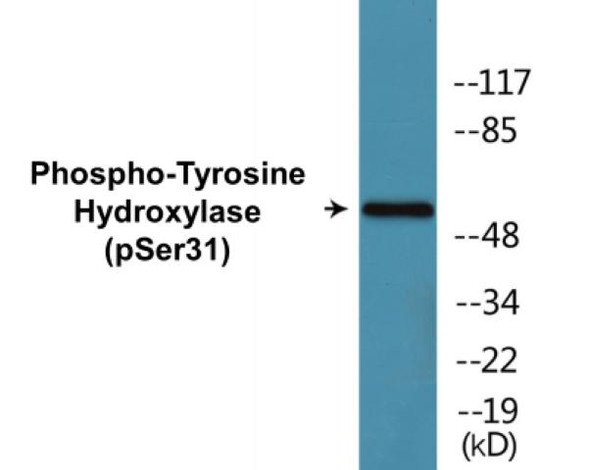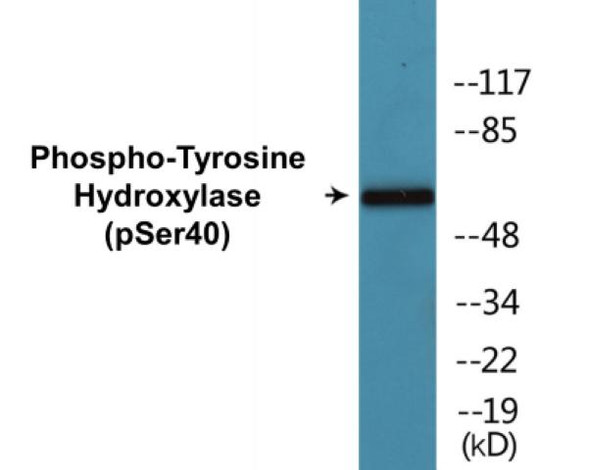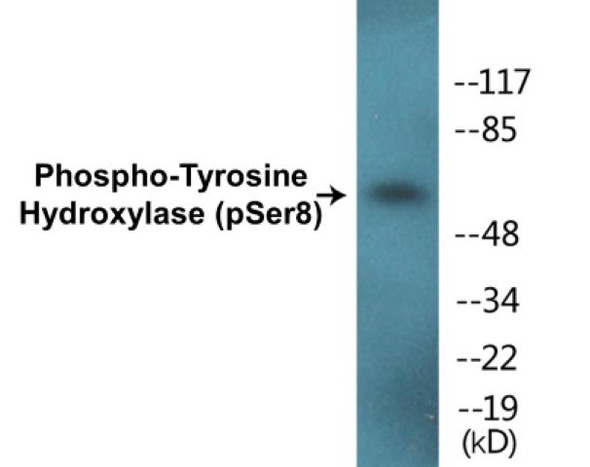Description
Tyrosine Hydroxylase (Phospho-Ser31) Cell-Based ELISA Kit
The Tyrosine Hydroxylase (Phospho-Ser31) Cell-Based ELISA Kit is a convenient, lysate- free, high throughput and sensitive assay kit that can monitor Tyrosine Hydroxylase phosphorylation and expression profile in cells. The kit can be used for measuring the relative amounts of phosphorylated Tyrosine Hydroxylase in cultured cells as well as screening for the effects that various treatments, inhibitors (ie. siRNA or chemicals), or activators have on Tyrosine Hydroxylase phosphorylation.
How does our Tyrosine Hydroxylase (Phospho-Ser31) Fluorometric Cell-Based ELISA Kit work?
Qualitative determination of Tyrosine Hydroxylase (Phospho-Ser31) concentration is achieved by an indirect ELISA format. In essence, Tyrosine Hydroxylase (Phospho-Ser31) is captured by Tyrosine Hydroxylase (Phospho-Ser31)-specific primary (1°) antibodies while Dye 1-conjugated and Dye 2-conjugated secondary (2°) antibodies bind the Fc region of the 1° antibody. Through this binding, the dye conjugated to the 2° antibody can emit light at a certain wavelength given proper excitation, hence allowing for a fluorometric detection method. Due to the qualitative nature of the Cell-Based ELISA, multiple normalization methods are needed:
| 1. | A monoclonal antibody specific for human GAPDH is included to serve as an internal positive control in normalizing the target RFU values. |
| 2. | An antibody against the nonphosphorylated counterpart of Tyrosine Hydroxylase (Phospho-Ser31) is also provided for normalization purposes. The RFU values obtained for non-phosphorylated Tyrosine Hydroxylase can be used to normalize the RFU value for phosphorylated Tyrosine Hydroxylase. |
Tyrosine Hydroxylase (Phospho-Ser31) Fluorometric Cell-Based ELISA Kit -Information
| Product Name: | Tyrosine Hydroxylase (Phospho-Ser31) Fluorometric Cell-Based ELISA Kit |
| Product Code/SKU: | FBCAB00006 |
| Description: | The Tyrosine Hydroxylase (Phospho-Ser31) Fluorometric Cell-Based Phospho ELISA Kit is a convenient, lysate-free, high throughput and sensitive assay kit that can monitor Tyrosine Hydroxylase (Phospho-Ser31) protein phosphorylation and expression profile in cells. The kit can be used for measuring the relative amounts of phosphorylated Tyrosine Hydroxylase (Phospho-Ser31) in cultured cells as well as screening for the effects that various treatments, inhibitors (ie. siRNA or chemicals, or activators have on TH phosphorylation. |
| Dynamic Range: | > 5000 Cells |
| Detection Method: | Fluorometric |
| Storage/Stability: | 4°C/6 Months |
| Reactivity: | Human, Mouse, Rat |
| Assay Type: | Cell-Based ELISA |
| Database Links: | Gene ID: 7054, UniProt ID: P07101, OMIM #: 191290/605407, Unigene #: Hs.435609/Hs.523414 |
| Format: | Two 96-Well Plates |
| NCBI Gene Symbol: | TH |
| Sub Type: | Phospho |
| Target Name: | Phospho-Tyrosine Hydroxylase (Ser31) |
Kit Principle
Figure: Schematic representation of Assay Genie Cell-Based Fluorometric ELISA principle
Kit components | Quantity |
| 96-Well Black Cell CultureClear-Bottom Microplate | 2 plates |
| 10X TBS | 24 ml |
| Quenching Buffer | 24 ml |
| Blocking Buffer | 50 ml |
| 15X Wash Buffer | 50 ml |
| Primary Antibody Diluent | 12 ml |
| 100x Anti-Phospho Target Antibody | 60 µl |
| 100x Anti-Target Antibody | 60 µl |
| Anti-GAPDH Antibody | 110 µl |
| Dye-1 Conjugated Anti-Rabbit IgG Antibody | 6 ml |
| Dye-2 Conjugated Anti-Mouse IgG Antibody | 6 ml |
| Adhesive Plate Seals | 2 seals |
Additional equipment and materials required
The following materials and/or equipment are NOT provided in this kit but are necessary to successfully conduct the experiment:
- Fluorescent plate reader with two channels at Ex/Em: 651/667 and 495/521
- Micropipettes capable of measuring volumes from 1 µl to 1 ml
- Deionized or sterile water (ddH2O)
- 37% formaldehyde (Sigma Cat# F-8775) or formaldehyde from other sources
- Squirt bottle, manifold dispenser, multichannel pipette reservoir or automated microplate washer
- Graph paper or computer software capable of generating or displaying logarithmic functions
- Absorbent papers or vacuum aspirator
- Test tubes or microfuge tubes capable of storing ≥1 ml
- Poly-L-Lysine (Sigma Cat# P4832 for suspension cells)
- Orbital shaker (optional)
Kit Protocol
This is a summarized version of the kit protocol. Please view the technical manual of this kit for information on sample preparation, reagent preparation and plate lay out.
| 1. | Seed 200 µl of desired cell concentration in culture medium into each well of the 96-well plates. For suspension cells and loosely attached cells, coat the plates with 100 µl of 10 µg/ml Poly-L-Lysine (not included) to each well of a 96-well plate for 30 minutes at 37°C prior to adding cells. |
| 2. | Incubate the cells for overnight at 37°C, 5% CO2. |
| 3. | Treat the cells as desired. |
| 4. | Remove the cell culture medium and rinse with 200 µl of 1x TBS, twice. |
| 5. | Fix the cells by incubating with 100 µl of Fixing Solution for 20 minutes at room temperature. The 4% formaldehyde is used for adherent cells and 8% formaldehyde is used for suspension cells and loosely attached cells. |
| 6. | Remove the Fixing Solution and wash the plate 3 times with 200 µl 1x Wash Buffer for 3 minutes. The plate can be stored at 4°C for a week. |
| 7. | Add 100 µl of Quenching Buffer and incubate for 20 minutes at room temperature. |
| 8. | Wash the plate 3 times with 1x Wash Buffer for 3 minutes each time. |
| 9. | Dispense 200 µl of Blocking Buffer and incubate for 1 hour at room temperature. |
| 10. | Wash 3 times with 200 µl of 1x Wash Buffer for 3 minutes each time. |
| 11. | Add 50 µl of Primary Antibody Mixture P to corresponding wells for Tyrosine Hydroxylase (Phospho-Ser31) detection. Add 50 µl of Primary Antibody Mixture NP to the corresponding wells for total Tyrosine Hydroxylase detection. Cover the plate with parafilm and incubate for 16 hours (overnight) at 4°C. If the target expression is known to be high, incubate for 2 hours at room temperature. |
| 12. | Wash 3 times with 200 µl of 1x Wash Buffer for 3 minutes each time. |
| 13. | Add 50 ul of Secondary Antibody Mixture to corresponding wells and incubate for 1.5 hours at room temperature in the dark. |
| 14. | Wash 3 times with 200 µl of 1x Wash Buffer for 3 minutes each time. |
| 15. | Read the plate(s) at Ex/Em: 651/667 (Dye 1) and 495/521 (Dye 2). Shield plates from direct light exposure. |
| 16. | Wash 3 times with 200 µl of 1x Wash Buffer for 5 minutes each time. |
Tyrosine Hydroxylase (Phospho-Ser31) - Protein Information
| UniProt Protein Function: | TH: an enzyme involved in the conversion of phenylalanine to dopamine. As the rate-limiting enzyme in the synthesis of catecholamines, tyrosine hydroxylase has a key role in the physiology of adrenergic neurons. Four splice variant isoforms have been described. |
| UniProt Protein Details: | Protein type:EC 1.14.16.2; Vesicle; Endoplasmic reticulum; Mitochondrial; Amino Acid Metabolism - tyrosine; Oxidoreductase Chromosomal Location of Human Ortholog: 11p15.5 Cellular Component: synaptic vesicle; internal side of plasma membrane; neuron projection; smooth endoplasmic reticulum; mitochondrion; dendrite; melanosome membrane; cytoplasm; terminal button; perikaryon; cytoplasmic vesicle; cytosol; nucleus Molecular Function:amino acid binding; protein domain specific binding; protein binding; enzyme binding; ferric iron binding; ferrous iron binding; dopamine binding; oxygen binding; tyrosine 3-monooxygenase activity Biological Process: heart morphogenesis; heart development; response to lipopolysaccharide; dopamine biosynthetic process; phytoalexin metabolic process; norepinephrine biosynthetic process; dopamine biosynthetic process from tyrosine; catecholamine biosynthetic process; response to electrical stimulus; epinephrine biosynthetic process; neurotransmitter biosynthetic process; response to pyrethroid; response to corticosterone stimulus; response to light stimulus; anatomical structure morphogenesis; phthalate metabolic process; mating behavior; social behavior; eye photoreceptor cell development; organ morphogenesis; circadian sleep/wake cycle; response to ethanol; response to zinc ion; cerebral cortex development; response to activity; response to water deprivation; synaptic transmission, dopaminergic; response to peptide hormone stimulus; locomotory behavior; fatty acid metabolic process; response to salt stress; regulation of heart contraction; response to estradiol stimulus; sensory perception of sound; visual perception; glycoside metabolic process; response to nutrient levels; terpene metabolic process; sphingolipid metabolic process; eating behavior; response to amphetamine; multicellular organismal aging; isoquinoline alkaloid metabolic process; response to herbicide; learning; response to ether; memory; synaptic vesicle amine transport; pigmentation; response to hypoxia; embryonic camera-type eye morphogenesis Disease: Segawa Syndrome, Autosomal Recessive |
| NCBI Summary: | The protein encoded by this gene is involved in the conversion of tyrosine to dopamine. It is the rate-limiting enzyme in the synthesis of catecholamines, hence plays a key role in the physiology of adrenergic neurons. Mutations in this gene have been associated with autosomal recessive Segawa syndrome. Alternatively spliced transcript variants encoding different isoforms have been noted for this gene. [provided by RefSeq, Jul 2008] |
| UniProt Code: | P07101 |
| NCBI GenInfo Identifier: | 239938945 |
| NCBI Gene ID: | 7054 |
| NCBI Accession: | P07101.5 |
| UniProt Secondary Accession: | P07101,Q0PWM2, Q0PWM3, Q15585, Q15588, Q15589, Q2M3B4 B7ZL70, B7ZL73, |
| UniProt Related Accession: | P07101 |
| Molecular Weight: | 528 |
| NCBI Full Name: | Tyrosine 3-monooxygenase |
| NCBI Synonym Full Names: | tyrosine hydroxylase |
| NCBI Official Symbol: | TH |
| NCBI Official Synonym Symbols: | TYH; DYT14; DYT5b |
| NCBI Protein Information: | tyrosine 3-monooxygenase; dystonia 14; tyrosine 3-hydroxylase |
| UniProt Protein Name: | Tyrosine 3-monooxygenase |
| UniProt Synonym Protein Names: | Tyrosine 3-hydroxylase; TH |
| UniProt Gene Name: | TH |
| UniProt Entry Name: | TY3H_HUMAN |







